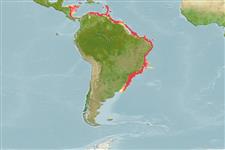>
Eupercaria/misc (Various families in series Eupercaria) >
Lutjanidae (Snappers) > Etelinae
Etymology: Pristipomoides: Greek, pristis = saw + Greek, poma, -atos = cover, operculum + Greek, oides = similar to (Ref. 45335).
Environment: milieu / climate zone / depth range / distribution range
Ecologia
marinhas demersal; intervalo de profundidade 50 - 220 m (Ref. 47377), usually 50 - 150 m (Ref. 9626). Tropical; 35°N - 36°S, 86°W - 33°W (Ref. 55)
Western Atlantic: southeastern USA to Uruguay (Ref. 9626).
Tamanho / Peso / Idade
Maturity: Lm ? range ? - ? cm
Max length : 23.3 cm TL macho/indeterminado; (Ref. 47377); common length : 21.0 cm TL macho/indeterminado; (Ref. 9626)
Espinhos dorsais (total): 10; Raios dorsais moles (total): 12; Espinhos anais 3; Raios anais moles: 8. Interorbital space flat. Eye large. Pectoral fins not reaching level of anus. Scale rows on back parallel to lateral line. Back and upper sides yellow-orange or pinkish; lower sides and belly silvery white; the caudal fin and the distal edge of the dorsal fin yellowish or orange; the remainder of the dorsal and other fins translucent or whitish.
Although the habitat is poorly known, most specimens have been trawled from relatively deep water at the upper edge of the continental shelf. Reported to occur on soft or semi-hard bottoms (Ref. 5217).
Life cycle and mating behavior
Maturidade | Reprodução | Desova | Ovos | Fecundidade | Larvas
Allen, G.R., 1985. FAO Species Catalogue. Vol. 6. Snappers of the world. An annotated and illustrated catalogue of lutjanid species known to date. FAO Fish. Synop. 125(6):208 p. Rome: FAO. (Ref. 55)
Categoria na Lista Vermelha da IUCN (Ref. 130435)
Ameaça para o homem
Harmless
Utilização humana
Pescarias: pouco comercial
Mais informação
Nomes comunsSinónimosMetabolismoPredadoresEcotoxicologiaReproduçãoMaturidadeDesovaAgregação para desovaFecundidadeOvosDesenvolvimento dos ovos
ReferênciasAquaculturaPerfil para aquaculturaEstirpesGenéticaElectrophoresesHereditariedadeDoençasProcessamentoNutrientsMass conversion
ColaboradoresFotografiasStamps, Coins Misc.SonsCiguateraVelocidadeTipo de nataçãoÁrea branquialOutras referênciasCérebrosVisão
Ferramentas
Relatórios especiais
Descarregue XML
Fontes da internet
Estimates based on models
Preferred temperature (Ref.
123201): 17.2 - 26.3, mean 22.2 °C (based on 127 cells).
Phylogenetic diversity index (Ref.
82804): PD
50 = 0.5005 [Uniqueness, from 0.5 = low to 2.0 = high].
Bayesian length-weight: a=0.01514 (0.00719 - 0.03187), b=2.97 (2.80 - 3.14), in cm total length, based on LWR estimates for this species & Genus-body shape (Ref.
93245).
Nível Trófico (Ref.
69278): 3.7 ±0.5 se; based on size and trophs of closest relatives
Resiliência (Ref.
120179): Elevada, tempo mínimo de duplicação da população menor que 15 meses (Preliminary K or Fecundity.).
Fishing Vulnerability (Ref.
59153): Low vulnerability (13 of 100).
